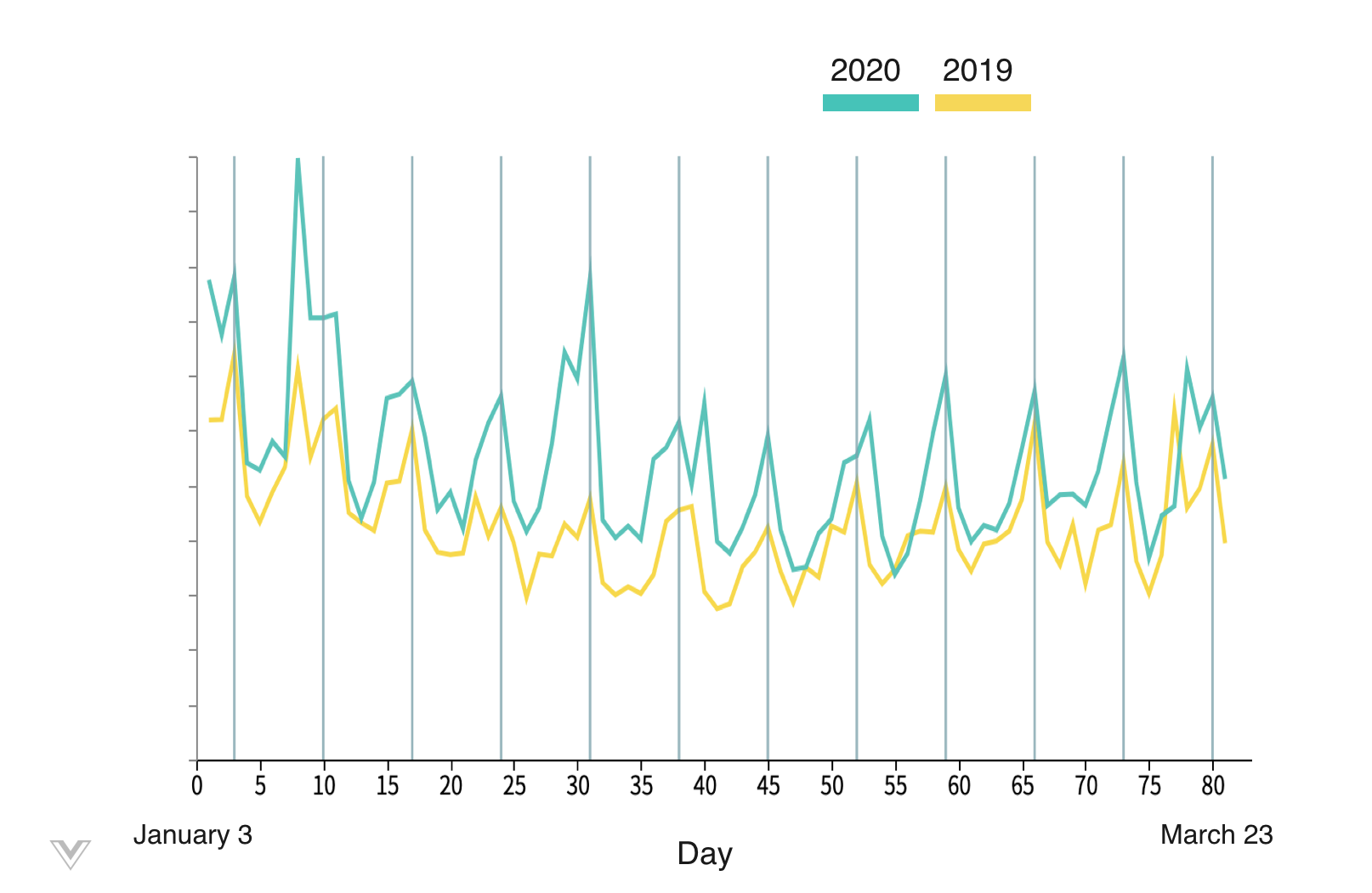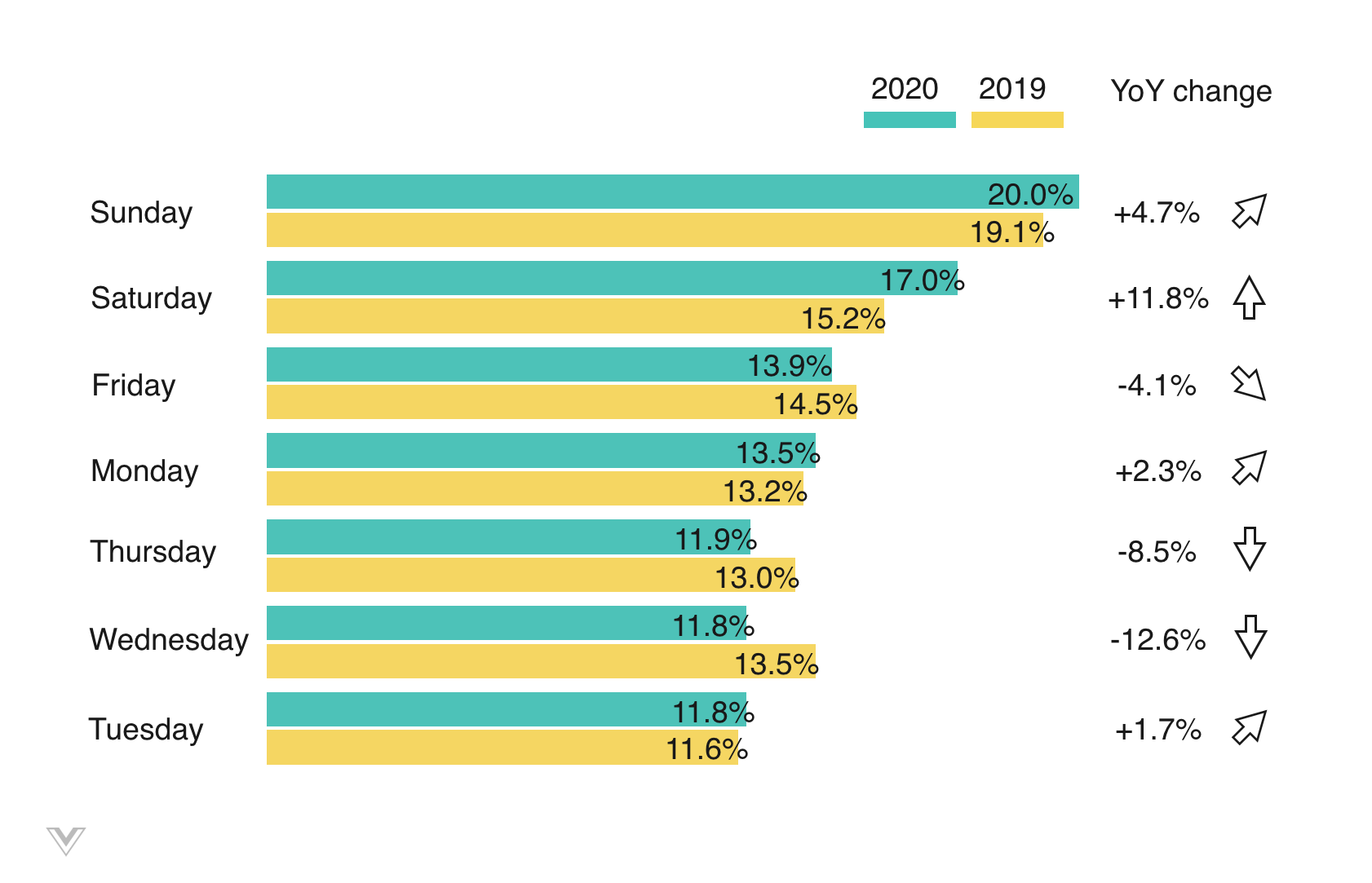■ Introduction
"We are currently faced with large challenges and worries for family, society and economy alike. Amid these challenges, the need for accurate information to make correct decisions and steps, are paramount.
If we can help our clients and partners in some small way by shedding light on the industry situation, we would consider that of utmost importance, which is why we decided to create a brief report on the impact of COVID-19 on the Japanese online fashion market."
Take care of yourselves and stay safe.
Inga Silkworth PhD, Head of Data Science at Virtusize
■ Summary
Online fashion sales remain strong, but shopping behavior changing amid COVID-19.
1. Overall, online fashion shopping revenue has been robust during the COVID-19 period. Both the number of orders and average order values have increased strongly compared to the same period last year (2019). However, there is indication that growth was set to have been even higher if not for the emergence of COVID-19, possibly due to lower overall consumption of fashion during this period.
2. Online fashion shopping has become even more concentrated to weekends during this period.
3. Peak times for online fashion shopping has shifted, from traditionally starting from 9pm to earlier 7pm.
Note: It is important to note that correlation does not equal causality and we reserve judgement on the exact extent of the impact of COVID-19 as it is one of many influencing factors on online fashion sales.
■ Findings
Fashion e-commerce revenues and order values robustduring COVID-19 so far.

The revenue of online fashion has grown by almost one fifth compared to the same period last year (2019). Given that Japanese fashion e-commerce has been growing between 10-20% per year in the last 5 years, this growth is on the high side. Interestingly, shoppers are not only increasing their orders but also buying more expensive items, while the number of items per order has been largely unaffected.

To get a closer view of the online fashion sales trend and to collaborate our finding regarding impact on revenue, we conducted a number of time series analysis over the selected period of COVID-19 impact and the same period in the previous year of 2019.We found that the revenue remains strong during the period of COVID-19 crisis in 2020.

However, the growth of revenue might have been slowed down by COVID-19 situation.
The impact on growth will likely become more clear in the coming weeks.
Concentration of online fashion shopping to weekends has strengthened further.

*The time period for this analysis of sales by weekday was adjusted to remove the effect of the Vernal equinox holiday.
Online fashion shopping is typically done on weekends. Interestingly, the COVID-19 situation has further concentrated online fashion shopping to Saturday and Sunday, with the two days accounting for a combined 37% of total shopping by revenue. This is likely also a result of more people opting to stay indoors during weekends rather than going outside to shop etc.
With this in mind, it can be seen that the approach to consumers is more effective on weekends.
Online fashion shopping now starts at 7pm instead of taking off from 9pm as before.

Traditionally, online fashion shopping takes off around 9pm, as people return home after work and outside activities. In the current situation, we found that would be shoppers are starting earlier, with shopping taking off as early as 7pm. This could be due to fewer people eating out or joining outside events, instead choosing to return home early. With social distancing becoming widespread, this trend could continue at least in the near future.
In that case, it seems necessary to adjust sales promotion measures according to the time of purchase.
■ Final thoughts
As our data indicated that online fashion revenue has seen YoY growth of around 20%, while multiple reports from external sources show that offline fashion sales has experienced a dramatic drop, there seems to have been a major shift in balance between the two channels.
Based on our data, it would seem as if the share of fashion total fashion sold online, last year estimated at around 11-12%, is currently exceeding 20%.
To what degree this shift in channel sales will persist is still too early to say. However, given that shifts to online in other mature consumer markets like Europe and US have been even stronger, topping 20% even before the start of COVID-19, the current trend might just mean that Japan is catching up and that online will continue to make up a larger share of fashion retail sales going forward.
■ Outline of the survey
Survey period (1) : From February 28, 2020 to March 23, 2020, when many public schools decided to close due to the impact of COVID-19
Survey period (2) : From March 1, 2019 last year to March 25, 2019, including the same number of days as survey period (1)
Survey data: Over 3.7 million online purchases from leading fashion e-commerce retailers in Japan
◆Click here for inquiries regarding this news.
■ Introduction
"We are currently faced with large challenges and worries for family, society and economy alike. Amid these challenges, the need for accurate information to make correct decisions and steps, are paramount.
If we can help our clients and partners in some small way by shedding light on the industry situation, we would consider that of utmost importance, which is why we decided to create a brief report on the impact of COVID-19 on the Japanese online fashion market."
Take care of yourselves and stay safe.
Inga Silkworth PhD, Head of Data Science at Virtusize
■ Summary
Online fashion sales remain strong, but shopping behavior changing amid COVID-19.
1. Overall, online fashion shopping revenue has been robust during the COVID-19 period. Both the number of orders and average order values have increased strongly compared to the same period last year (2019). However, there is indication that growth was set to have been even higher if not for the emergence of COVID-19, possibly due to lower overall consumption of fashion during this period.
2. Online fashion shopping has become even more concentrated to weekends during this period.
3. Peak times for online fashion shopping has shifted, from traditionally starting from 9pm to earlier 7pm.
Note: It is important to note that correlation does not equal causality and we reserve judgement on the exact extent of the impact of COVID-19 as it is one of many influencing factors on online fashion sales.
■ Findings
Fashion e-commerce revenues and order values robustduring COVID-19 so far.

The revenue of online fashion has grown by almost one fifth compared to the same period last year (2019). Given that Japanese fashion e-commerce has been growing between 10-20% per year in the last 5 years, this growth is on the high side. Interestingly, shoppers are not only increasing their orders but also buying more expensive items, while the number of items per order has been largely unaffected.

To get a closer view of the online fashion sales trend and to collaborate our finding regarding impact on revenue, we conducted a number of time series analysis over the selected period of COVID-19 impact and the same period in the previous year of 2019.We found that the revenue remains strong during the period of COVID-19 crisis in 2020.

However, the growth of revenue might have been slowed down by COVID-19 situation.
The impact on growth will likely become more clear in the coming weeks.
Concentration of online fashion shopping to weekends has strengthened further.

*The time period for this analysis of sales by weekday was adjusted to remove the effect of the Vernal equinox holiday.
Online fashion shopping is typically done on weekends. Interestingly, the COVID-19 situation has further concentrated online fashion shopping to Saturday and Sunday, with the two days accounting for a combined 37% of total shopping by revenue. This is likely also a result of more people opting to stay indoors during weekends rather than going outside to shop etc.
With this in mind, it can be seen that the approach to consumers is more effective on weekends.
Online fashion shopping now starts at 7pm instead of taking off from 9pm as before.

Traditionally, online fashion shopping takes off around 9pm, as people return home after work and outside activities. In the current situation, we found that would be shoppers are starting earlier, with shopping taking off as early as 7pm. This could be due to fewer people eating out or joining outside events, instead choosing to return home early. With social distancing becoming widespread, this trend could continue at least in the near future.
In that case, it seems necessary to adjust sales promotion measures according to the time of purchase.
■ Final thoughts
As our data indicated that online fashion revenue has seen YoY growth of around 20%, while multiple reports from external sources show that offline fashion sales has experienced a dramatic drop, there seems to have been a major shift in balance between the two channels.
Based on our data, it would seem as if the share of fashion total fashion sold online, last year estimated at around 11-12%, is currently exceeding 20%.
To what degree this shift in channel sales will persist is still too early to say. However, given that shifts to online in other mature consumer markets like Europe and US have been even stronger, topping 20% even before the start of COVID-19, the current trend might just mean that Japan is catching up and that online will continue to make up a larger share of fashion retail sales going forward.
■ Outline of the survey
Survey period (1) : From February 28, 2020 to March 23, 2020, when many public schools decided to close due to the impact of COVID-19
Survey period (2) : From March 1, 2019 last year to March 25, 2019, including the same number of days as survey period (1)
Survey data: Over 3.7 million online purchases from leading fashion e-commerce retailers in Japan
◆Click here for inquiries regarding this news.
■ Introduction
"We are currently faced with large challenges and worries for family, society and economy alike. Amid these challenges, the need for accurate information to make correct decisions and steps, are paramount.
If we can help our clients and partners in some small way by shedding light on the industry situation, we would consider that of utmost importance, which is why we decided to create a brief report on the impact of COVID-19 on the Japanese online fashion market."
Take care of yourselves and stay safe.
Inga Silkworth PhD, Head of Data Science at Virtusize
■ Summary
Online fashion sales remain strong, but shopping behavior changing amid COVID-19.
1. Overall, online fashion shopping revenue has been robust during the COVID-19 period. Both the number of orders and average order values have increased strongly compared to the same period last year (2019). However, there is indication that growth was set to have been even higher if not for the emergence of COVID-19, possibly due to lower overall consumption of fashion during this period.
2. Online fashion shopping has become even more concentrated to weekends during this period.
3. Peak times for online fashion shopping has shifted, from traditionally starting from 9pm to earlier 7pm.
Note: It is important to note that correlation does not equal causality and we reserve judgement on the exact extent of the impact of COVID-19 as it is one of many influencing factors on online fashion sales.
■ Findings
Fashion e-commerce revenues and order values robustduring COVID-19 so far.

The revenue of online fashion has grown by almost one fifth compared to the same period last year (2019). Given that Japanese fashion e-commerce has been growing between 10-20% per year in the last 5 years, this growth is on the high side. Interestingly, shoppers are not only increasing their orders but also buying more expensive items, while the number of items per order has been largely unaffected.

To get a closer view of the online fashion sales trend and to collaborate our finding regarding impact on revenue, we conducted a number of time series analysis over the selected period of COVID-19 impact and the same period in the previous year of 2019.We found that the revenue remains strong during the period of COVID-19 crisis in 2020.

However, the growth of revenue might have been slowed down by COVID-19 situation.
The impact on growth will likely become more clear in the coming weeks.
Concentration of online fashion shopping to weekends has strengthened further.

*The time period for this analysis of sales by weekday was adjusted to remove the effect of the Vernal equinox holiday.
Online fashion shopping is typically done on weekends. Interestingly, the COVID-19 situation has further concentrated online fashion shopping to Saturday and Sunday, with the two days accounting for a combined 37% of total shopping by revenue. This is likely also a result of more people opting to stay indoors during weekends rather than going outside to shop etc.
With this in mind, it can be seen that the approach to consumers is more effective on weekends.
Online fashion shopping now starts at 7pm instead of taking off from 9pm as before.

Traditionally, online fashion shopping takes off around 9pm, as people return home after work and outside activities. In the current situation, we found that would be shoppers are starting earlier, with shopping taking off as early as 7pm. This could be due to fewer people eating out or joining outside events, instead choosing to return home early. With social distancing becoming widespread, this trend could continue at least in the near future.
In that case, it seems necessary to adjust sales promotion measures according to the time of purchase.
■ Final thoughts
As our data indicated that online fashion revenue has seen YoY growth of around 20%, while multiple reports from external sources show that offline fashion sales has experienced a dramatic drop, there seems to have been a major shift in balance between the two channels.
Based on our data, it would seem as if the share of fashion total fashion sold online, last year estimated at around 11-12%, is currently exceeding 20%.
To what degree this shift in channel sales will persist is still too early to say. However, given that shifts to online in other mature consumer markets like Europe and US have been even stronger, topping 20% even before the start of COVID-19, the current trend might just mean that Japan is catching up and that online will continue to make up a larger share of fashion retail sales going forward.
■ Outline of the survey
Survey period (1) : From February 28, 2020 to March 23, 2020, when many public schools decided to close due to the impact of COVID-19
Survey period (2) : From March 1, 2019 last year to March 25, 2019, including the same number of days as survey period (1)
Survey data: Over 3.7 million online purchases from leading fashion e-commerce retailers in Japan
◆Click here for inquiries regarding this news.


.svg)



.avif)
.avif)

.avif)
.png)
